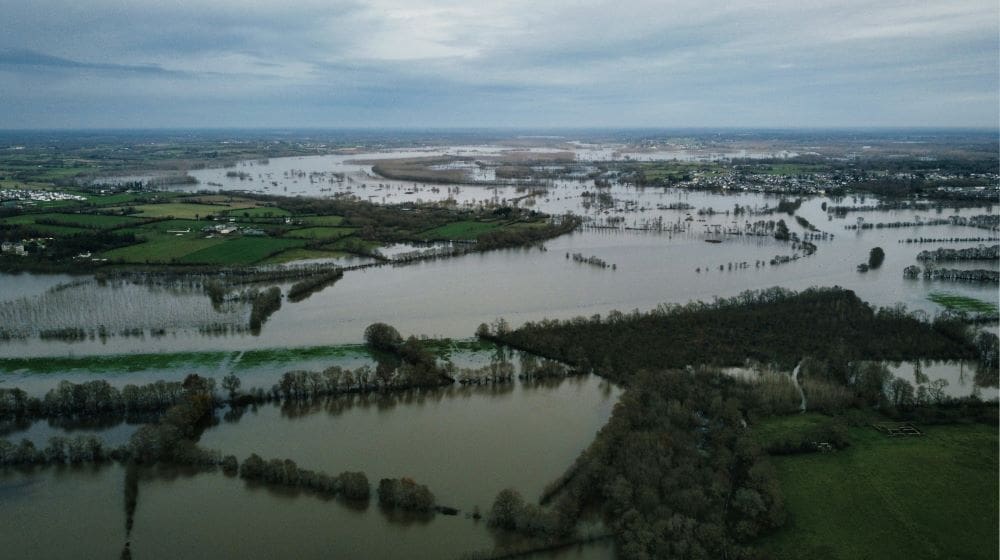Summary:
Flooding has long been one of Europe’s costliest natural hazards, but a new study shows that adaptation has significantly reduced its toll. Researchers from the Potsdam Institute for Climate Impact Research (PIK) examined 70 years of data on 1,729 riverine, flash, coastal, and compound flood events across the continent. Their analysis, published in Science Advances, reveals that measures such as early warning systems, emergency preparedness, building regulations, and other protective strategies have reduced economic losses by 63 percent and fatalities by 52 percent since 1950.
The study shows that while more people and assets are now located in flood-prone areas, vulnerability has declined thanks to improved risk management. Economic losses have risen in absolute terms – from €37 billion in the 1950s to €71 billion in the past decade – yet relative to GDP, flood damages now amount to just one-third of what they were 70 years ago. Regional differences remain, with western and southern Europe seeing greater progress in adaptation than eastern and northern regions.
The authors caution, however, that recent progress has slowed and that climate change has already increased flood damages by about eight percent, pushing adaptation closer to its limits.

70 years of data show adaptation reducing Europe’s flood losses
The study analyses seven decades of historical flood impacts across Europe and demonstrates how adaptation measures have reduced damage over time.
Flood damage is the result of the interaction between hazards, such as heavy rainfall or storm surges, exposure, i.e., how many people and assets are located in vulnerable areas, and vulnerability, i.e., how badly these areas can be affected by flooding.
“Flood protection and other adaptation measures have largely offset the increasing flood risk from expansion into flood plains and climate change across the continent since 1950,” explains Dominik Paprotny, a PIK researcher and the lead author of the attribution study. “Vulnerability has been significantly reduced, but progress in adaptation has been slower in the past 20 years, indicating the need for additional efforts to prevent an increase in flood losses from climate change in the future.”
According to the study, economic losses in Europe due to flooding and the number of people affected have increased by around eight percent since 1950 due to climate change. The research team examined 1,729 floods that occurred across Europe between 1950 and 2020, comparing them in scenarios with and without climate and socioeconomic changes since 1950.
Using historical damage data from these events, the researchers were able to also deduce changes in the level of protection provided by measures such as dykes, dams, early warning systems and changed building regulations at the European level over time. Their results show that increased exposure has dominated the increase in damages. However, improved protective measures and reduced vulnerability have partially offset this trend.
Damages relative to GDP have fallen to one-third
The study identifies the factors behind long-term trends in flood damage in Europe, revealing clear regional differences: Flood protection levels have improved more in western and southern Europe than in eastern and northern parts of the continent. Moreover, the study shows, that vulnerability has declined across the continent – with few exceptions, particularly for the population affected in parts of eastern Europe.
Absolute economic losses have almost doubled from 37 billion euros between 1950 and 1960 to 71 billion euros over the past decade. However, relative to the gross domestic product (GDP) of the study area, the economic impact has decreased significantly in percentage terms, now amounting to around one-third of that in the 1950s. This is because economic growth since the 1950s has outpaced the increase in damages.
Adaptation has its limits
“We can reduce damage through adaptation, but adaptation has its limits,” says Katja Frieler, lead of the international climate impact model inter-comparison project ISIMIP at PIK and co-author of the study. “As warming increases, we are getting closer to those limits.” In the past four years, multiple particularly severe floods have occurred, such as the Ahrtal flood in Germany in 2021.
“It is important to continuously monitor progress in adaptation and the impacts of climate change, and to swiftly cut global greenhouse gas emissions to keep climate change impacts within manageable limits,” Frieler concludes.
Journal Reference:
Dominik Paprotny, Aloïs Tilloy, Simon Treu, Anna Buch, Michalis I. Vousdoukas, Luc Feyen, Heidi Kreibich, Bruno Merz, Katja Frieler, Matthias Mengel, ‘Attribution of flood impacts shows strong benefits of adaptation in Europe since 1950’, Science Advances 11, 33 (2025). DOI: 10.1126/sciadv.adt7068
Article Source:
Press Release/Material by Potsdam Institute for Climate Impact Research (PIK)
Featured image credit: Mathis Mauprivez | Unsplash




